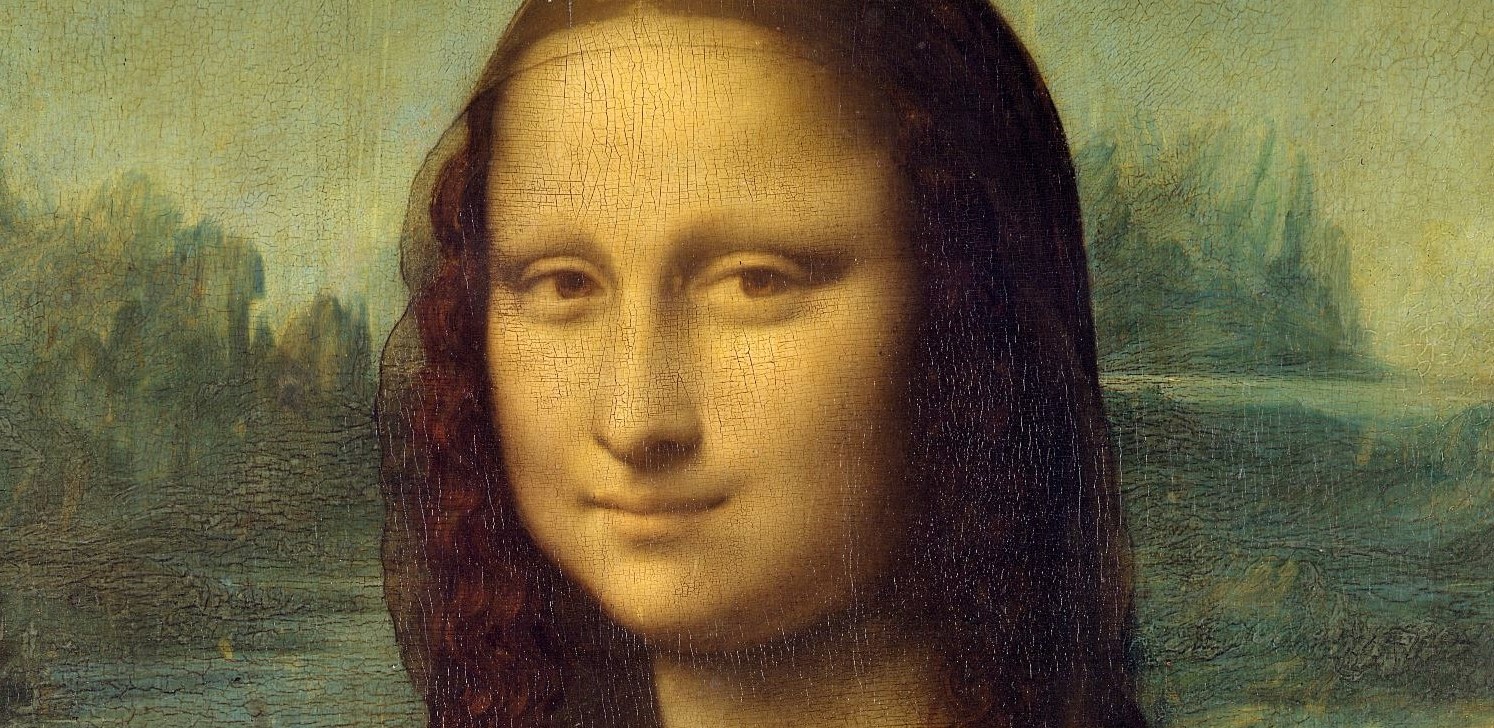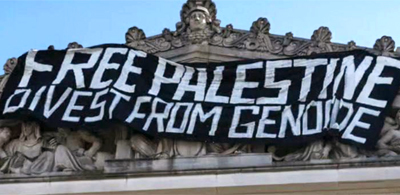The Mona Lisa Curse
In these “postmodern” days it has been said that there is no more passé a vocation than that of the professional art critic. Perceived as the gate keeper for opinions regarding art and culture, the art critic has supposedly been rendered obsolete by an ever expanding pluralism in the art world, where all practices and disciplines are purported to be equal and valid.
Robert Hughes, however, is one art critic who has delivered a message that must not be ignored.
On Sept. 18, 2008, British television’s Channel 4 broadcast The Mona Lisa Curse, a documentary film by Mr. Hughes that offered a devastating critique of contemporary art and its over commercialization. While a DVD release of The Mona Lisa Curse has not been made, complete versions of the film have been published online. Links to the streaming videos are found at the end of this essay. In my article below I summarize each segment of the film. I encourage one and all to view the documentary in its entirety.

In The Mona Lisa Curse, Hughes has described with remarkable clarity the forces seeking to tame art, putting it in the service of plutocrats. The market driven and controlled cultural landscape outlined by Hughes reminds me of what the Italian political theorist and revolutionary Antonio Gramsci once said of society in decline; “The old is dying. The new cannot be born. In the interregnum, a variety of morbid symptoms appear.” The candor and forthrightness of Hughes in identifying the trap art is currently ensnared in should be responded to as a call to arms, especially by artists.
The Curse: Part 1
Hughes opens his film by comparing Leonardo da Vinci’s Mona Lisa, with Damien Hirst’s, For the Love of God. Hughes tells us that; “What ties the Mona Lisa to this glittery bobble is their role in a giant shift in the art world, that shift is all about money. It’s a story that I’ve watch unfold during the last 50 years. I’ve seen with growing disgust; the fetishization of art, the vast inflation of prices, and the effect of this on artists and museums. The entanglement of big money with art has become a curse on how art is made, controlled, and above all – in the way that it’s experienced. And this curse has affected the entire art world.”
“Apart from drugs, art is the biggest unregulated market in the world, with contemporary art sales estimated at around $18 billion a year. (….) Boosted by regiments of nouveau riche collectors, and serviced by a growing army of advisors, dealers and auctioneers. As Andy Warhol once observed, ‘Good business is the best art.'”
The Curse: Part 2
In 1962 the Mona Lisa was temporarily loaned to New York’s Metropolitan Museum of Art by the Louvre in Paris for the painting’s first exhibit in the United States. Over one million Americans filed past Leonardo da Vinci’s masterpiece – including President Kennedy and First Lady Jacqueline Kennedy. As Hughes noted about the display of the Mona Lisa; “People came not to look at it, but to say that they’d seen it. (….) The painting made the leap from artwork to icon of mass consumption.” The postmodernist period of art as commodity and mass spectacle had begun.

“(….) If anyone had told Leonardo that 500 years after his death, his portrait would be the most famous painting in the word, he’d have thought the notion mad. In 1963 in New York, the Mona Lisa was now treated like it was a photo in a magazine. To be quickly scanned and then discarded.
When Andy Warhol heard the painting was coming to New York, he quipped: ‘Why don’t they have someone copy it and send the copy, no one would know the difference.'”
The Curse: Part 3
Hughes recalls his early days in the vibrant late 1960s art scene of New York, where he met and befriended the likes of Pop artist Robert Rauschenberg (1925-2008) and James Rosenquist (1933-).
Rent was cheap, art was affordable, and anyone interested in purchasing original artworks could do so for a song – as art was not yet considered a profit making investment. Hughes adds; “In just a few years this would change, art as commodity would begin to take over from art as art.”
The Curse: Part 4
I found this segment particularly interesting, since I wrote about the history it covered in a 2008 web log post titled, The Unveiling of Robert Scull. In this clip Hughes uses historic footage to tell the tale; “On the 18th of October, 1973, the Sculls auctioned off 50 works from their collection through Sotheby Park-Bernet, Inc. This was the first time a collector from that small contemporary art world treated their collection as an investment.”
The Curse: Part 5
This segment is a continuation of the Scull auction saga from part 4. According to Hughes, “American contemporary art as a serious ‘commodity’ was about to be born.” (….) The Scull auction shifted the art world’s emphasis from aesthetics to money. From now on, not just art lovers, but everyone would want a piece of the action. Contemporary art and big money would be ever more closely entwined.”
The Curse: Part 6
Hughes argues that contemporary art is expensive, not because of any intrinsic spiritual or historic worth, but because it makes for good investments that yield high profits. “The consequences of such prices, was that art became admired, not through any critical perspective, but for its price tag. Auction houses were the new arbiters of taste.” (….) The prices, they have a cultural function – their cultural function is to strike you blind, so that you can’t make your own judgments.”
A particularly funny scene in the documentary is when Hughes visits the Metropolitan Museum of Art in New York to view a Damien Hirst ‘sculpture’ – a dead shark suspended in a tank of formaldehyde titled; The Physical Impossibility of Death in the Mind of Someone Living. Barely concealing his amusement Hughes calls the pickled shark; “The world’s most overrated marine organism” – adding that Hirst’s work is “a comedy, but a kind of tacky comedy too, that bears a lot upon the way that we think about art and how it is made.”
The Curse: Part 7
In this segment Hughes tells us that; “At the age of 70, I belong to the last generation that could spend time in a museum without ever once thinking about what the art might cost.” Hughes delves into the changing role and function of art museums, interviewing Philippe de Montebello, the director of the Metropolitan Museum of Art in New York from 1978 to 2008.
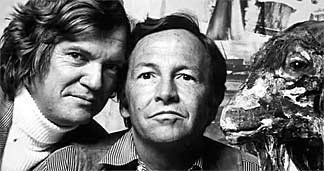
Also interviewed is the affable Thomas Hoving, who served as the director of the Metropolitan Museum of Art from 1967 to 1977. Hoving ushered in profound changes in museum culture, using public relations and advertising for the very first time in history to promote museum exhibits. Hoving was the first to allow corporations to underwrite or sponsor museum exhibitions – paving the way to today’s increased corporate control of art institutions.
On the role of museums, Hughes says; “The way that art is experienced in these spaces has changed beyond recognition. The museum has adopted the strategy of mass media; an emphasis on spectacle, the cult of the celebrity masterpiece, art clocked through the blink of an eye or through the lens of a camera. But what it’s gained through an increase in these numbers, it’s lost in terms of freedom of access and availability to the eye and the mind.”
The Curse: Part 8
This portion of the video deals with the recent transformation of art museums into business franchises. The former director of the Guggenheim Museum, Thomas Krens, states in an interview; “The Tate is a brand, the Louvre is a brand – is the Guggenheim a brand, I guess it is.” Hughes comments that “Krens is renowned for putting on shows of Giorgio Armani, in return for massive underwriting from – guess who? – and for franchising the Guggenheim around the world. He pioneered the museum’s global brand, building Guggenheims in Bilbao, Berlin, and Venice, with varying degrees of success and failure.”
In his interview, Krens also said; “If you look at this in global terms, it’s probably in some sense related to the power and importance of brands that represent quality. Quality automobiles, quality wristwatches, or quality cultural objects.” That Mr. Krens can equate the world’s cultural heritage to “quality wristwatches” is telling. Hughes observed that; “Krens’ agenda to popularize the museum is a euphemistic and more palatable way of saying how the art market transforms the museum into a commercial model.”
The Curse: Part 9
Hughes speaks of the commodification of art, saying that in order “To give everyone their Mona Lisa, you must escalate the production process.” The artist’s studio literally becomes an industrial unit churning out “product”, as with Warhol’s “factory.” On the subject of Warhol, Hughes said the following; “I admired some of his work in the 60s and early 70’s, but he turned into a dull celebrity business man branded to the hairline. It was as good as printing dollar bills. The dominance of the art market has produced multiple Andys – global brands like Jeff Koons and Damien Hirst.”
Hughes examines the role of “art advisors” who peddle misleading information to clueless wealthy clients regarding art as investment; “CEO’s and art speculators have created a feeding frenzy, and they’re serviced by a swarm of art advisors buzzing and crawling around the jam jar.”
The Curse: Part 10
Hughes converses with New York art dealer Richard Feigen, who says; “A menu of certain favored artists has gotten expensive because they have been promoted – this is my opinion – and it has very little to do with how important they are (….) If you have an artist that has a huge supply, it permits promotion of the artist. You can have exhibitions everywhere; it’s worth people’s while to promote it. But some of the stuff that’s consequential doesn’t get shown because it isn’t trendy. Why isn’t it trendy – I’ve just explained, basically it’s not worth anyone’s while to make it trendy.”
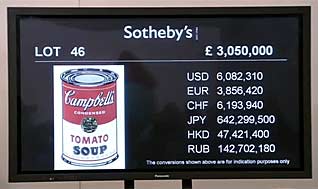
Hughes also focuses on mega-collector and art dealer, Alberto Mugrabi. The men of the Mugrabi family – father Jose and his two sons, Alberto and David, have some 800 works by Warhol in their collection of more than 3,000 works; a private collection thought to be the largest and most expensive in the world.
Mugrabi is shown at Sotheby’s Auction House bidding with his father on a painting by “appropriation” artist Richard Prince – a painting that sold for $7.4 million. Mugrabi professed; “We support these artists by promoting them, by buying them at auction, by buying them privately – you could say it’s a way of controlling it.”
The Curse: Part 11
This is my favorite portion of the documentary. It shows Hughes visiting the Lever House skyscraper in New York City for an interview with collector Alberto Mugrabi. The bottom floor of the building is where the Lever House Art Collection is located; a project conceived by real estate tycoon Aby Rosen and Alberto Mugrabi in 2003 as a way to inject corporate art into the public sphere. At the ground floor courtyard at Lever House, Hughes is confronted by The Virgin Mother, Damien Hirst’s 35ft-tall statue of a young pregnant woman that shows half of the woman’s skin and tissue removed to reveal the fetus.
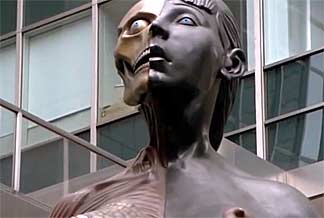
Hughes surveys the sculpture and says; “Isn’t it a miracle what so much money and so little ability can produce? Just extraordinary. You know, when I look at a thing like this I realize that, so much of art – not all of it thank god, but a lot of it – has just become a kind of cruddy game for the self-aggrandizement of the rich and the ignorant, it is a kind of bad but useful business.”
The Hughes interview with Alberto Mugrabi is priceless; a confrontation between two philosophies, one that extols art as spiritual and necessary to the human heart, the other that sees art strictly in business terms. Hughes is sagacious, looking all the world like some great wise owl as he controls the discussion from his perch. Mugrabi attempts to hold his own but he is clearly outgunned. It is remarkable to see Mugrabi, a man who shapes, manipulates, and controls a fair share of the elite art world, reduced to babbling in the presence of an opinionated art critic who speaks his mind. A typical exchange in the conversation follows:
Hughes: “You take Richard Prince to be an artist of significance, do you?”
Mugrabi: “Absolutely”
Hughes: “What is significant about his work?”
Mugrabi: “He’s a guy that has his own ideas… he’s a person that has done a lot of different types of work…”
Hughes (interrupting): “But Richard Prince’s works seems to consist of basically two types. One is those rather weak jokes, and the other one is the transcription of photographs in paint.”
Mugrabi: “He’s such a deep person that maybe you don’t see it in his paintings – but he definitely is.”
Hughes: “If he is why does one not see it in his paintings?”
Mugrabi: (momentarily struck silent) “Cuz… I, I see it… I think, I think…”
The Curse: Part 12
Hughes wraps up his documentary with some final words;
“Some think that so much of today’s art mirrors and thus criticizes decadence, not so – it’s just decadent, full stop. It has no critical function, it is part of the problem. The art world beautifully copies our money driven, celebrity obsessed, entertainment culture; same fixation on fame, same obedience to mass media that jostles for our attention with its noise and wow and flutter.”
“For me, the cultural artifact of the last 50 years has been the domination of the art market. Far more striking than any individual painting or sculpture. It has changed art’s relationship to the world and is drowning its sense of purpose.”
“If art can’t tell us about the world we live in, then I don’t believe there’s much point in having it. And that is something we are going to have to face more and more as the years go on; that nasty question which never used to be asked because the assumption was always that it was answered long ago – ‘What good is art?, What use is art, what does it do? Is what it does actually worth doing? – and an art which is completely monetized in the way that it’s getting these days, is going to have to answer these questions or it is going to die.”
________________________________
Where to watch The Mona Lisa Curse: The brilliant 2008 documentary by Robert Hughes, can be viewed in its entirety on WatchDocumentaries, and also here. Inexplicably, the film has not been released a DVD.
On Aug. 16, 2012, I wrote an obituary for Hughes titled, Robert Hughes: the last art critic.



